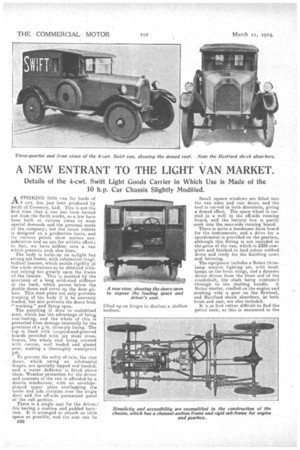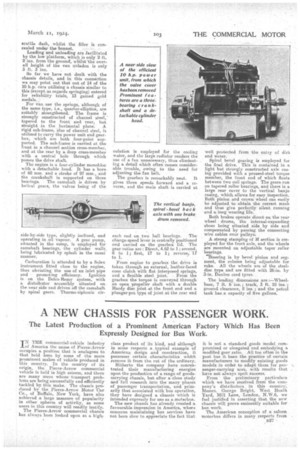A NEW ENTRANT TO THE LIGHT VAN MARKET.
Page 10

Page 11

If you've noticed an error in this article please click here to report it so we can fix it.
Details of the 4-cwt. Swift Light Goods Cartier in Which Use is Made of the 10 h.p. Car Chassis Slightly Modified.
ASTRIKING little van for loads of 4 cwt. has just been produced by Swift of Coventry, Ltd: This is not the first time that a van has been turned out from the Swift works, as a few have been built at various times to meet special demands and the personal needs of the company; but the latest vehicle is designed on a production basis, and it& various points show mature consideration and an eye for artistic effect; in fact, we have seldom seen a . vail which presents such nice lines.
The body is built; up on allight but strong ash frame, with substantial longi"tudinal bearers, which enable rigidity of the whole structure to be obtained without relying too greatly upon the frame of the chassis. This is assisted by the provision of a long mild-steel stiffener at the back, which passes below the double doors and turns up the door pillars. This steel plate not only prevents warping of the body if it be unevenly loaded, but also prevents the doors from "
working" and flying open.
The panelling is done in coslettised steel, which has the advantage of being non-rusting, and the whole of this is protected from damage internally by the provision of a 1-in. three-ply lining. The top is lined with tongued-and-grooved boards provided with six stout crossbraces, the whole roof being covered with canvas, well leaded and glazed over, making a thoroughly waterproof job. To prevent the entry of rain, the rear doors, which swing on substantial hinges, are specially lapped and beaded, and a water deflector is fitted above them. Weather protection for the driver and contents of the van is afforded by a double windscreen, with an envelopeshaped upper plate overlapping the lower and side curtains over the single door and the off-side permanent panel of the cab portion. There is a single seat for the driver,1 this having a eushion and padded backrest. It is arranged to absorb as little space as possible, and the seat can be n26 . lifted rip on hinges to disclose a shallow toolbox. Small square windows are fitted into the van sides And rear doors, and the roof is curved in both directions, giving a domed effect. The spare wheel is carried in a well in the off-side running board, and the battery box is partly sunk into the near-side running board.
There is quite a handsome facia board for the irmtruments, and a drive for a speedometer is provided on the gearbox, although this fitting is not included in the price of the van, which is £235 complete and finished in lead colour Tubbed down and ready for the finishing coats and lettering. The equipment includes a Rotax threelamp electric lighting set, with head. lamps on the front wings, and a dynamo direct driven from the front end of the crankshaft, the shaft being continued through to the starting handle. A Rotax starter, cradled on the engine and meshing with a gear on the flywheel, and Hartford shock absorbers, at both front, and rear, are also included. It is at first rather difficult to find the petrol tank, as this is ensconced in the scuttle clash, whilst the filler is con
cealed under the -bonnet. Loading and unloading are facilitated by the low platform, which is only 2 ft. 2 ins, from the ground, whilet-the overall height of the van unladen is only 5 ft. 3 ins.
So far we have not dealt with the chassis details, and in this connection we may point out that out of 14 of the 10 h.p. cars utilizing a chassis similar to this (except. as regards springing) entered for reliability trials, 13 gained gold medals..;
For van use the springs, although of the same type, i.e., quarter-elliptics, are suitably strengthened. The frame is strongly constructed of channel steel," tapered to the front and rear, but
straight in the horizontal plane. A rigid. sub-frame; also of channel steel, is utilized to carry the power unit and gearbox, which are both four-point supported. The sub-frame is carried at the front in a channel section crosa-member, and at the rear by a deep cressoriember with a central hole through which passes the drive shaft.
The engi,ne is a four-cylinder monobloc with a detachable head. It has a bore of 60 mm. and a 'stroke of 97 mm., and the crankshaft is supported on three bearings. The camshaft is driven by helical gears, the valves being of the
side-by-side type, slightly inclined, and operating in oil vapour. A gear, pump, situated in the, sump, is employed for camshaft bearings, the cylinder walls, being lubricated by splash in the usual manner,
Carburation is attended to by a Soles instrument fitted close to the engine, thus obviating the use of an inlet pipe and • promoting efficiency. Ignition is on the Del co-Remy system, with a distributor accessibly situated on the near side and driven off the camshaft by spiral gears. Thermo-siphonic cir culation is employed for the cooling water, and the large radiator renders the use of a. fan mmecessary, thus eliminating a detail which often causes consider., able trouble, owing to the need for adjusting the fan belt,.
The gearbox is remarkably neat. It gives three speeds forward and a reverse, and the main shaft is carried at each end on two ball bearings. The change-speed lever is centrally positioned and carried on the gearbox lid. The gear reties are : Direct., 4.62 to 1; second, 8 to 1; first, 17 to 1; reverse, 17 to 1.
From engine to gearbox the drive is taken through an external, leather-faced cone clutch with flat interposed springs, and a flexible steel joint. From the gearbox the torque is conveyed through an open propeller shaft with a double Hardy disc joint at the front end and a plunger-pot type of joint at the rear end well protected from the entry of dirt and water.
Spiral bevel gearing is employed for the final drive. This is contained in a light but strongly constructed axle casing provided with a pressed-steel torque member, the front end of which floats between two coil springs. The gears run on tapered roller bearings, and there is a large rear cover to the vertical banjo casing, which allows for easy inspection. Both pinion and crown wheel can easily be adjusted to obtain the correct mesh and thus give perfectly silent running and a. long wearing life.
Both brakes operate direct on the rear wheel drums, the internal-expanding shoes being situated side by side and compensated by passing the connecting wire cables over pulleys: A strong stamping of H section is employed for the front axle, and the wheels are mounted on adjustable taper roller bearings.
7teering is by bevel pinion and segment, the column being adjustable for rake. All the wheels are of the steeldisc type and are fitted with 26-in. by 3-in. Dunlon cord tyres.
The leading dimensions are :—Wheelbase, 7 ft. 6 ins.; track, 3 ft. 10 ins. ; ground clearance, 8 ins. ; and the petrol tank has a capacity of five gallons.
































